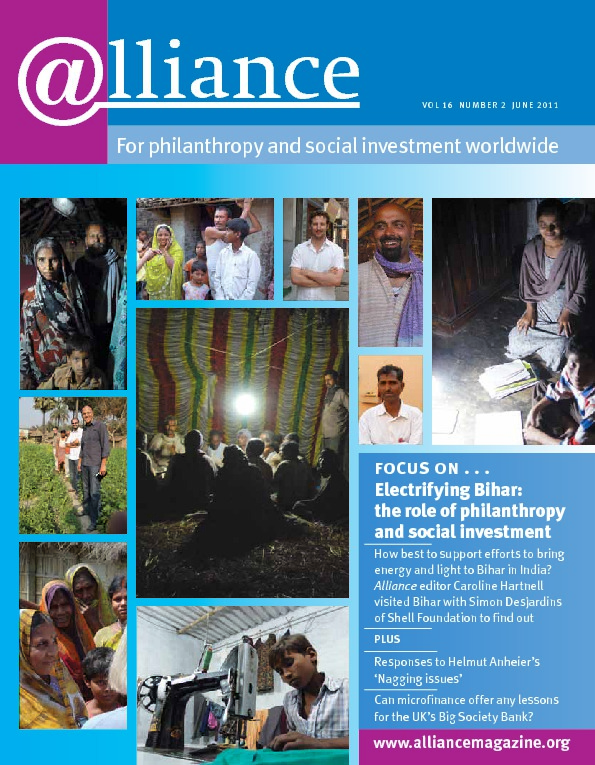Chris West, Shell Foundation
Shell Foundation’s overriding mission is to catalyse scalable and sustainable solutions to big global development challenges, and we have a particular interest in energy poverty. Experience in Africa convinced us that the best vehicles for fulfilling our aims are small enterprises with the ability to extend access to a range of affordable and appropriate technologies. Our strategy is to invest in start-ups.
The real challenge is not the technology; it’s finding good entrepreneurs who are capable of delivering the services. Husk Power quickly came to our attention. The issue was right, the team seemed right, the technology was interesting and it was in a geographical area where we felt we had some market knowledge.
It is one of a series of direct investments Shell Foundation has made in India. In the case of Husk Power, the grants were initially used to allow them to build more plants to demonstrate proof of concept, take on more competent staff early on, develop systems, including health and safety procedures, and offset some of their R&D costs. We also invest expertise. Our overall aim is to try to position the enterprise so that it can go to scale quicker and more sustainably.
We also try to take them to the next stage of financing, helping them to secure investors who will put in non-grant money. This is the sticking point, finding the next stage of financing that will help enterprises like Husk Power gain access to mainstream capital markets. India needs hundreds if not thousands of Husk Powers.
For more information
http://www.shellfoundation.org
Jacqueline Novogratz, Acumen Fund
Husk Power is important to Acumen Fund in that it reinforces the fact that what impact investing should be doing first and foremost is meeting a need – in this case, bringing affordable, clean energy to some 22,000 villages in Bihar – rather than producing a financial return. Early subsidies to Husk Power from Shell Foundation and the Ministry of New and Renewable Energy enabled Acumen to invest patient capital. The margins are small but the investment is worth it because of the huge potential impact.
It also illustrates that there is a role for private investors to work with government and the philanthropy sector to achieve long-term sustainable development. Different kinds of capital are needed for different stages of a company’s growth. If we can get a clearer idea of which kind of funding is right for each circumstance, we can get a better idea of where government is needed.
Karthik Chandrasekar adds …
Acumen was already invested in d.light, which really brought the idea of design and quality into the solar, portable lighting space. So we were looking for a company that would jump-start the mini-grid sector in the same way. Husk Power’s aim is to get to 2,014 plants by 2014 – but 2,014 plants will still reach only 1 per cent of the target population.
I think the main thing that differentiates Husk Power from other players who do biomass gasification projects and generate electricity for the poor is the scale at which they operate and the expectations they have of the community to help them scale. The others expect entrepreneurs to come up and provide anchor loads to a power plant: they will set up a 100 kilowatt plant if the village starts a rice mill, a wheat-grinding mill, an ice-making machine and five other things. But why would any villager want to risk his capital on an expectation that somebody’s going to be providing power? This is basically why a lot of the other players have been stuck in the one or two plants mode and not moved forward. But Husk Power has a very simple model: if around 100 households in a village are ready to sign up for basic lighting (2 CFL bulbs), they will build a plant.
For more information
http://www.acumenfund.org
Eric Berkowitz and Keith Allman, Oasis Fund (advised by Bamboo Finance)
Our goal is to support innovative, commercially viable enterprises designed to generate both significant social impact and solid financial return, directly benefiting low-income communities. We were attracted to Husk Power because we see affordable clean energy as a major need and Husk Power is one of the few producers targeting off-grid communities in a sustainable way. We have great confidence in the management team, which is local, which is vital in a place like Bihar. We also like the model and see its great potential impact in Bihar, in other parts of India, and in other rice-producing countries. It could even be adjusted to use other fuels. The pricing makes sense. There is no other use for rice husks – they even present a disposal problem – and the Husk Power model provides a secondary income source for rice producers. Thus, it solves many problems at a stroke.
For more information
http://www.bamboofinance.com
Wolfgang Hafenmayer, LGT Venture Philanthropy
Husk Power is in many ways a perfect fit with our mission to improve the quality of life of less advantaged people. In Bihar many people are very poor, earning $150-$200 a year. Bringing electricity to villages gives people the means to start small businesses, earn money, afford things they couldn’t previously afford.
LGT’s due diligence found a very professional local team. Tough managers who understand the local situation are vital to ensure that the money is spent well, and Husk Power has these. The work was well implemented, and there was the potential to grow fast. Money from Shell Foundation had already proved that the model works, and it was an area where for-profit venture capital wouldn’t go: returns are too low at this stage. The initial $1.3 million needed was too large an investment for LGT, but it worked for us to come in as part of a group of investors.
Our one concern is about staffing. We assumed that if Husk Power provided jobs running plants, people would be happy to have them. But farmers are proud and see working for someone else as losing face, so it wasn’t easy. It’s becoming easier now it’s clear that Husk Power isn’t going to disappear suddenly.
For more information
http://www.lgt.com/en/private_kunden/philanthropie/index.html
Hemant Mandal, International Finance Corporation
IFC focuses on getting business models up and running, with the aim of making them replicable locally, nationally and globally. Our special interest is in sustainable business models, so clean energy is a perfect fit. And Bihar is a natural focus for IFC because it is a state that has not traditionally been part of India’s growth story in the past, despite abundant resources and talent and significant unmet needs, and we think solutions developed there will be relevant to any mini-grid system in any emerging economy. We are actually looking at other mini-grid deals, but HPS is the only one that is developed and ready to scale
We have two roles with Husk Power: providing finance, debt and equity, in connection with which we are on the board, and giving very specific advisory help relating to setting up a management information system, which is what their CEO requested. We are also helping Husk Power to develop its training programme for operators and mechanics. Our aim is to help them to get systems in place to enable them to scale up in a manageable way: going from 65 to over 2,000 units in three years is a very ambitious target.
We have our biggest impact by making a business model sustainable and commercial so that the private sector will come in. So we need to make Husk Power stronger and encourage other similar businesses, so creating a larger group for banks and other private investors.
At around $1.5 million, this is one of the smallest deals IFC has ever done. This means transaction costs are high, so in effect there is a trade-off against social impact. But we really believe in this model and want to support it.
For more information
http://www.ifc.org
Neera Nundy, Dasra Social-Impact
Dasra’s role with Husk Power has evolved as they have expanded. We worked on syndicating the first round of ‘pre-series A’ funding. Our role was to make sure funders’ expectations were realistic and that Husk Power was getting what it needed.
We are now helping them to look for grant funding for a training institute: the shortage of trained people is a huge gap in India generally and in Bihar particularly. People from urban areas generally don’t want to move to rural areas – hence the importance of the institute in developing local talent. But it must have a broader mission than providing good staff for Husk Power otherwise it will be seen as existing to support a for-profit organization.
Last year Ratnesh Yadav, Husk Power co-founder and COO, participated in Dasra Social-Impact, our capacity-building programme, which looks at developing a business plan, increasing impact, etc.
For more information
http://www.dasra.org
Funding to Husk Power
- October 2008 Shell Foundation grant of $164,000 for three plants (there were already three)
- July 2009 Shell Foundation grant of $279,000 for five more plants, bringing total to 11
- September 2009 ‘Pre series A’ fundraising round consisted of:
- Acumen Fund $375,000
- Oasis Fund (advised by Bamboo Finance) $375,000
- LGT Venture Philanthropy $300,000
- DFJ and Cisco $125,000 each as prize money for business plan competitions
- April 2010 International Finance Corporation invested $350,000 as part of a $1.5 million commitment
- July – December 2010 Shell Foundation grant of $550,000 for HSSE (Health Safety Security Environment), R&D, human resources and training, marketing and financial management
- January – November 2011 Shell Foundation grant of $1.1 million for HSSE, R&D, human resources and training
- October 2011 Series A fundraising round to raise $5 million to $6 million
 Reflections on a day out with Husk Power
Reflections on a day out with Husk Power
As an investor in Husk Power, I’ve read about them on paper and seen plans of the plant and pictures, but seeing how it links to the community and how they use the electricity – I wanted to see how that felt. Seeing businesses like the rice mill moving in and downstream businesses like the incense sticks was really fascinating, and gives credence to the idea that this will be catalytic not only to the household but also to micro economic development.
The other question for us is what is the team capable of doing? And how actively does Gyanesh need to be involved with each of the 65 plants? I assume we went on three or four unannounced visits and on each occasion the plants were staffed and running smoothly, and that’s a sign of being ready to scale.
There aren’t many in our portfolio who have 65 of anything, so Husk Power has one of the largest physical footprints. Having said that, 25 of their plants are close together, a manageable drive from each other. 2,014 plants is not manageable with the current team. So what do they need to do in order to make that happen?
Brian Trelstad is chief operating officer, Acumen Fund. Email btrelstad@acumenfund.org




Comments (0)